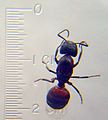| Revision as of 10:36, 28 January 2006 editDuk (talk | contribs)10,888 edits added images← Previous edit | Revision as of 11:26, 28 January 2006 edit undoDuk (talk | contribs)10,888 editsNo edit summaryNext edit → | ||
| Line 1: | Line 1: | ||
| {{Taxobox begin | color = pink | name = Carpenter ant}} | {{Taxobox begin | color = pink | name = Carpenter ant}} | ||
| {{Taxobox image | image = ] | caption = |
{{Taxobox image | image = ] | caption = Carpenter ant}} | ||
| {{Taxobox begin placement | color = pink}} | {{Taxobox begin placement | color = pink}} | ||
| {{Taxobox regnum entry | taxon = ]ia}} | {{Taxobox regnum entry | taxon = ]ia}} | ||
Revision as of 11:26, 28 January 2006
Template:Taxobox begin Template:Taxobox image Template:Taxobox begin placement Template:Taxobox regnum entry Template:Taxobox phylum entry Template:Taxobox classis entry Template:Taxobox ordo entry Template:Taxobox familia entry Template:Taxobox genus entry Template:Taxobox end placement Template:Taxobox section subdivision
- see text
Carpenter ants are large, black ants (1/4" - 1") indigenous to large parts of the world. They prefer dead, damp wood in which to build nests. It is believed the species of poison arrow frogs that are toxic become so through their diet, which consists in part of carpenter ants.
Species
- Camponotus atriceps
- Camponotus chromaiodes
- Camponotus ferrugineus (Fab.), Red Carpenter Ant
- Camponotus nearcticus (Emery), Smaller Carpenter Ant
- Camponotus pennsylvanicus (DeGeer), Black Carpenter Ant
- Camponotus variegatus
External links
- University of Kentucky Extension Fact Sheet (Mike Potter)
- Ohio State University Extension Fact Sheet (William F. Lyon)
This insect-related article is a stub. You can help Misplaced Pages by expanding it. |


